By Arundhuti Dasgupta Singhal and Rajrishi Singhal
The thing with the Himalayas is that it shifts shapes. The vista changes with every turn around one of those mountainous, sinuous bends, presenting a fresh perspective of the world’s youngest mountain range, breathtaking in its majesty and hypnotic in its beauty. The hues slip away as the winding roads gain altitude, the lush green of ancient, towering conifers yielding to the rough-hewn but spectacular rusts and greys which, as the altimeter crosses 12,000 feet, eventually gets draped in the pristine white of freshly-fallen snow.
The mountains are mysterious creatures, capable of carrying an entire universe within their stoic frames; as the American poet Emily Dickinson (1830-1886) wrote:
The mountain sat upon the plain,
In his eternal chair,
His observation omnifold,
His inquest everywhere.
The seasons prayed around his knees,
Like children round a sire:
Grandfather of the days is he,
Of dawn the ancestor.
The mountains have always held us spellbound, making our hearts ache every time we leave them behind for the grubbiness of our cities; and, we never stop looking for ways to find our way back into their enigmatic presence. But this time was different: we were not just coming to meet the mountains, but were seeking one of its most elusive denizens, a creature whose lithe frame has captivated millions across the world, since the beginning of time.
We were headed to Chicham, a village in the Spiti Valley in Himachal Pradesh, that is located at a height of close to 14,000 feet above sea level. Our trip, six months in planning, was a snow leopard expedition and while we hoped for the best (a close sighting), we were prepared for the worst (being snowed indoors with a cup of coffee and a book).
But let us not get ahead of ourselves. To even give ourselves a chance to meet the leopard, we had to first get on the road to Chicham, in many ways one of the last human outposts in the Spiti Valley. We rode past half frozen lakes, gurgling waterfalls and soaked in the deep hum of the Sutlej that roared past us for much of our journey. Gradually, the colours of the sky mixed with the land around us as we drove into a sea of snow and a barrenness of unspeakable beauty.
This stunning landscape, we must say, flatters to deceive. The thick snow carpet hides deep crevices, the alluring ledges on the mountain-side are an optical illusion obscuring a sheer drop from their edges, and the weather is mercurial most times. The trees whisper and sing. The sky wears a thousand faces and the rock faces and caves speak a language that we don’t recognize any more. And then there is the fauna, most of which is difficult to spot: blue sheep, the red fox, the near-extinct bearded vulture, wolves, the sure-footed mountain goat (or ibex) and, cresting the food chain, the elusive snow leopard.
Aah, the snow leopard! The snow leopard is not easy to spot because its home in the mountains is usually at heights beyond human reach. But for a short period in winter, when the peaks are covered in snow, they come down the slopes looking for prey and, maybe, a change of scenery. The best months to spot the leopard are January and February, but we were making the trip in March (see box) and were a bit apprehensive as to whether we would be granted a darshan.
Chicham, a small village, comprising not more than 30-40 houses and a small Buddhist monastery, was to be our staging post, for five days. The village is perched on the side of a mountain, overlooking the Spiti river as it brings down waters from glaciers further north and rushes down to meet the Sutlej, roughly 160km to the south. Our home was the Tethys Himalayan Den, located at the highest point in the village and could be spotted a mile away from any point on the road. It had taken us four days to get here, after landing in Chandigarh on the morning of Holi.
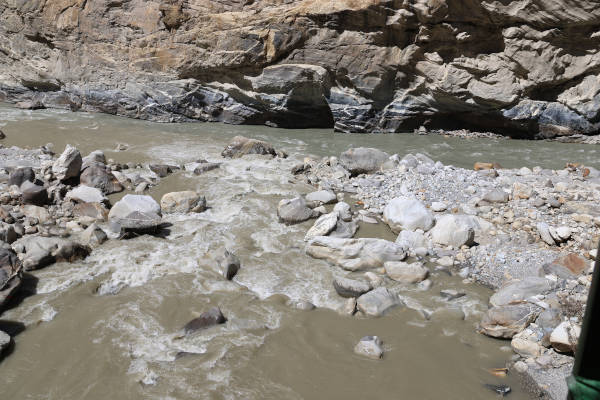
[The Sutlej merging into Spiti river]
We had deliberately chosen to pace our drive up the hills because it was important that we gradually acclimatized ourselves to the high altitudes. The air gets thinner as we go higher and the rarefied atmosphere makes routine tasks seem strenuous; here beauteous nature is also at its most brutal, where the weather is tricky and unpredictable. The Banjara team had helped us draw up a 13-day itinerary, with 4 night-halts on the way up to Chicham and one on our way down.
The team had also tasked one of its most experienced men with the responsibility of driving us around; Karamchand (KC), a cheerful man with a steady hand at the wheel. He immediately endeared himself to us by saying that no matter what he does, he cannot escape the call of Spiti. “The mountains keep calling me and I love going back again and again,” he said with a smile.
Setting out for the road trip
We left Chandigarh, early on the morning of March 26. The wide expressway out of the city allowed KC to maintain a comfortable pace all the way out of Punjab/Haryana; even after crossing the state border into Himachal Pradesh and through the uphill drive to Solan. The nightmare began once we reached the outskirts of Shimla; apart from having to countenance ugly, rampant construction which has defaced and choked the old hill station, we had to navigate heavy commuter traffic on roads not designed for so many cars. What should have taken us 30 minutes to traverse, took us more than 90 minutes.
Our first stop was Woodvista Cottages in Cheog, about an hour away from Shimla, deep in the valley, thick in the middle of apple orchards. A night was all we had there and so we made the most of the evening by going out for a short walk into the woods. We were looking for a pond, which we never found, but all around us were apple trees sheathed in nets. This is a common sight in these areas during March-April when entire mountainsides are swathed with white nets or plastic sheets to protect the fruit crop, which is harvested sometime around October, from ruinous hail stones.
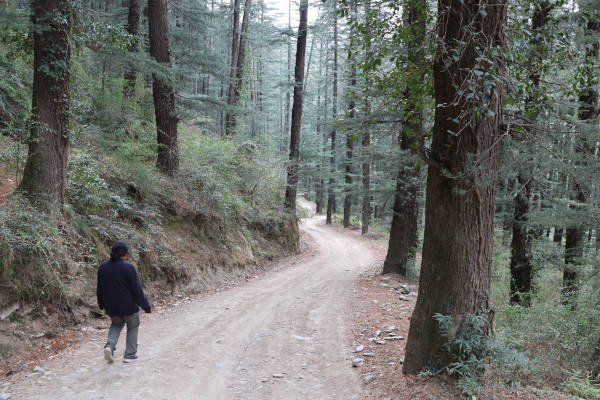
[Cheog woodlands]
The next day (Wednesday, March 27) we were headed to Sangla in Kinnaur district—a 210-km journey. It was going to be a long day and we were out early.
Our road took us up a steep ride to Theog and then past Narkanda and Kumarsain, where we took a hard right and entered the Sutlej valley, the road overlooking the river for most part of the journey.
The Sutlej is one of the most ancient rivers in the region, it carries the history of generations in its stride and also the hopes of modern India in the form of many large hydro-electric projects, including the country’s largest 1500-MW Nathpa Jhakri plant.
The river was the saving grace for this part of the journey because the roads are a crumbly mass of pebble and rock. It took us some time therefore to get to Kharchham where we had to part ways with the Sutlej and travel next to its tributary, Baspa. Another hour of driving took us into Sangla and Banjara’s encampment on the riverside, close to a village called Batseri.
This was not our first time in Sangla. We had loved it so much the first time that we opted for a two-night halt here. During our stay, we walked through the village and drove to the ancient Kamru fort, which is an interesting structure. It is built like a tower with the bottom two floors made of stone and the top five floors entirely made of wood. To enter the fort, we had to hike up a steep slope and then walk in through a temple, and this is where we encountered an India that is rapidly morphing into an ugly version of itself; imposing new-found religious restrictions and re-imagining religious purity in exclusionary terms.
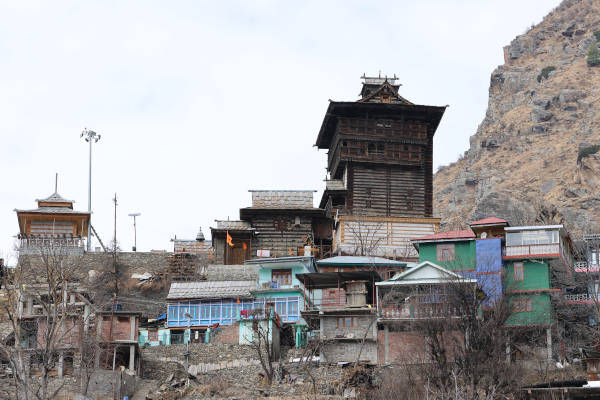
[Kamru Fort]
As we bent down to take off our shoes, a caretaker stepped out from behind a closed door and quizzed us about the contents of our breakfast. When we admitted to consuming eggs, she said we can’t be allowed inside. Our attempts at logic—that animal sacrifices are commonplace for Kamakhya Devi, one of the main deities of the temple—failed to make any headway. Incidentally, there was no such restriction when we had visited the temple and the fort 20 years ago! Speaking of non-vegetarian food, visitors to Sangla must try the catch from a trout farm in the area. At Banjara’s camp, we loved it when it came grilled with only butter, salt and pepper.
Onward to Chicham
The climb from Sangla to Chicham was the toughest part of the journey, requiring KC’s experience and deft handling of the large vehicle on rocky and narrow mountain roads. We slept as much as possible, to minimize exertion, and kept sipping water infused with oral rehydration salts.
The drive took us past a rapidly changing topography and a land that is steeped in history and legend. We were constantly reminded how old this region is, when we looked at the strange formations on the mountain side and met people who spoke in lyrical tongues that seemed to emerge from a timeless time.

[The snowclad Spiti landscape]
All along the road, we were always acutely aware of the proximity of the China border. The Chinese presence was felt in many different ways; the Sutlej originates there as do many other tributaries of even the Spiti river (the Parchu river, for example). At one point on the National Highway 505 we were told that we were barely 15-20 km from the border. History, conflict and friendship and a relationship that goes back centuries were all baked into the roads that drove us up to Spiti.
KC told us that we must see a lake that would leave us spellbound (and it did). This was at Nako (altitude 11,900 feet), under the shadow of Reo Purgyal, Himachal’s highest mountain (22,362 feet). Nako has one of the region’s oldest Buddhist monasteries (1025 AD) and a natural lake considered sacred by locals. It was partially frozen when we visited and locals claimed that the lake affords skating during winter.
Further down the road is Tabo with a slightly older monastery (996 AD) which Wikipedia claims is the “oldest continuously operating Buddhist enclave in both India and the Himalayas”. This monastery is protected by the Archeological Survey of India and houses fascinating frescoes which were painted centuries ago with natural dyes. Old and fading, these frescoes tell the story of Buddhism in the region and a visit to the monastery is highly recommended, sooner rather than later, because the wall paintings may soon fade beyond recognition as restoring them seems like a perilous undertaking.
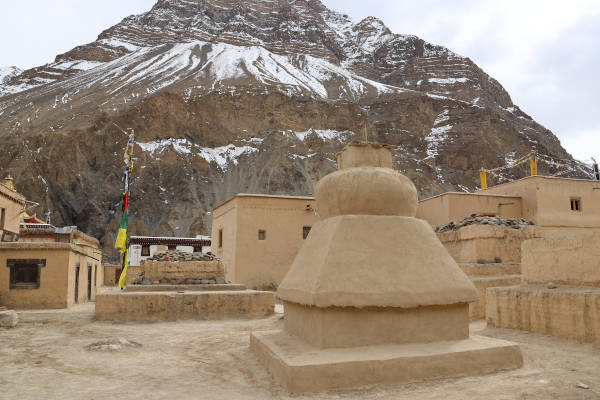
[Tabo monastery’s courtyard]
The air started getting thinner Nako onwards and, as if in concert, the temperature began to drop too. We climbed up to almost 12,000 feet to reach Kaza, the sub-divisional headquarters and source for fuel and necessary provisions for neighbouring villages. A few miles past Kaza, NH505 crosses the Spiti river and heads towards Atal Tunnel from where the road forks off towards Manali and Ladakh. We did not take that road but took a narrower, rockier road for another hour to reach Chicham bridge, which is the gateway to Chicham village. The bridge is an engineering feat, a suspension stiffened steel truss bridge, providing a motorable path over the Sambha Lamba Nallah (another Spiti tributary) and a popular selfie point for tourists.
By the time we reached our destination it was close to 6pm. But the long and slow ride up, interspersed with sage advice from KC to keep sipping water, ensured that we had minimal discomfort during the 14,000-feet sojourn. We went to bed that night, wondering what the morning held in store. Would a leopard emerge from the snowy edges of the mountain or would we have to stay holed inside, as the evening predicted a night of snow?
The morning was a picture in white. Everywhere we looked, every rooftop in the village was covered with snow. The window sills were hemmed with beautifully transparent icicles and snow finches scurried around the ground. This was a new visual indulgence: an undulating white world as far as the eye could see.
At breakfast that morning, Faraz, who works with Banjara and carries the nomadic spirit of its founders, told us that we would have to spend the day indoors. He broke it to us gently, because there are some who can quickly lose their cool in a place that tests your physical and mental strength every step of the way. But we were quite relieved really. It meant a day of rest and some time for our bodies to adjust to the temperature.
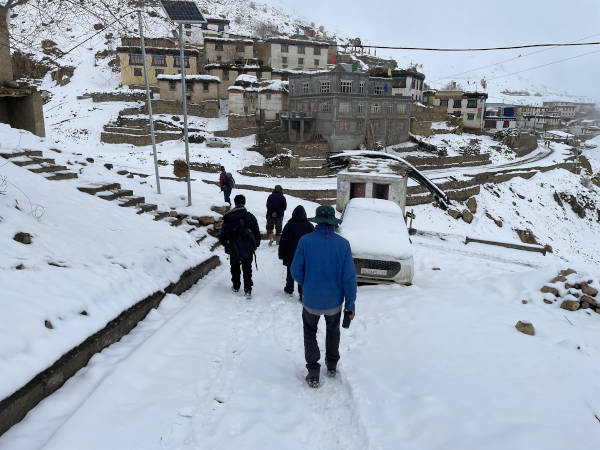
[Trekking through Chicham]
It also turned out to be an exciting one. We were taken along for a brisk walk in the village, led by Tenzing, our hardy and extremely resourceful guide-cum-man-who-can-do-almost-everything. The walk was to acquaint ourselves with the terrain, walking on snow swaddled in all the specialised clothing. Tenzing made sure that we learnt how to step gently but firmly into the snow, balance our weight carefully and measure our steps gingerly, to keep our breath flowing smoothly. He chatted away, all through the walk, taking us to see an ancient board game that is still played in the village—a lot of shouts and thumps with every roll of the dice is what we could figure out and also that there is an element of money involved, if the participants so want.
As we walked around, we saw people everywhere shovelling snow. Some had shovels, some were using homemade contraptions that looked like a stick gummed into a flat pan and some were using their gloved hands. It is hard, back breaking work. But that did not stop them from yelling out Julley (Hello) and urging us to come in for a cup of tea.

[Women spinning yarn from yak hair]
Tenzing and his friendly aide, Lolong, insisted that we go to a home where some women from the village had congregated to make yarn out of yak hair. It was a warm room where a group of 6-7 women of varying ages—mothers, grandmothers and young daughters—sat around chatting and tossing the hair into tiny balls and squeezing them into thin strands of yarn. One look at us heaving in through the door and they were a pile of giggles. And, before we could even blink, they had engaged us into a conversation about our lives, our families and exchanging news about the world outside. Come back, they told us as we went out. I wish we could have, but then the next day brought a different adventure altogether.
We woke up the next morning to see 6-7 inches of fresh snow cover. Leopard spotting seemed unlikely, but when it stopped snowing around 9-10 am, our trackers—two resourceful and enthusiastic young men—were quick to get out in the field. They had not managed to locate them but, even so, they suggested that we take a trip out into the field. We drove up to the point beyond which no cars are allowed. And then walked, rather stumbled, down thick rolls of snow to clamber up rock faces and perch precariously on thin ledges with sheer drops.

[The sure-footed ibex]
We managed to spot a herd of ibex, with some large males leading the pack. The leaders, or bucks, were large (about 40-45 inches high), sported red beards and large, notched horns. The herd, while viewing us rather contemptuously, was busy foraging for hardy shrubs that grow even in snow. Ibex usually descend from the mountain heights in winter and this particular herd seemed to be slowly regaining the heights. Ibex, or mountain goats, are incredibly sure-footed, giving us loads of inferiority complex while reminding us that the terrain belonged to them; we are just interlopers, unsure of our footing and, as a species, harmful to the ecology.
The next day we left again after breakfast. The sun was out though the temperature was in the minus-5-10-degrees-centigrade range, the air smelt of hope. We made our way back to the field, which was sheathed in a white blanket of snow. In some places, the snow was stacked high up to the knees; each step had to be taken deliberately, after ensuring that the foothold could bear the body weight along with all the luggage on our backs.
After an exhausting trek of close to a kilometre in the snow, climbing down a sheer face, negotiating a walk along a thin ledge not broader than 12-14 inches, and balancing our way down another outcrop, we pitched camp on a precipice overlooking the Spiti river. On the right was an entire mountainside draped in snow and, across the gorge, the leeside of another mountain barren and brown in stark contrast. The trackers pointed us to two snow leopards resting on a ledge, invisible to the untrained eye, their coat merging into the variegated rocky hues. They must have been about 800-1000 metres away, across the deep canyon.
The leopards were sub-adult siblings, a brother and sister abandoned by the mother early in their childhood when she went walkabout in search of fresh hunting pastures. We set up the tripod by finding a right spot with minimum incline to achieve the right balance, fitted the two lenses (800-mm super telephoto and a 2X extender) to the tripod and the camera to the lenses, tested the stability of the structure, aimed it at the supine siblings and settled down for a prolonged stake-out. Interestingly, there was an ibex herd right above the cats and another herd slightly below them. Both species seemed alert to each other’s presence but let the other be. The leopard pair stirred a bit towards noon, changed positions but remained somnolent. It was in the afternoon that they disentangled from each other, stretched out and headed out for a stroll, checking out other animals in the vicinity.
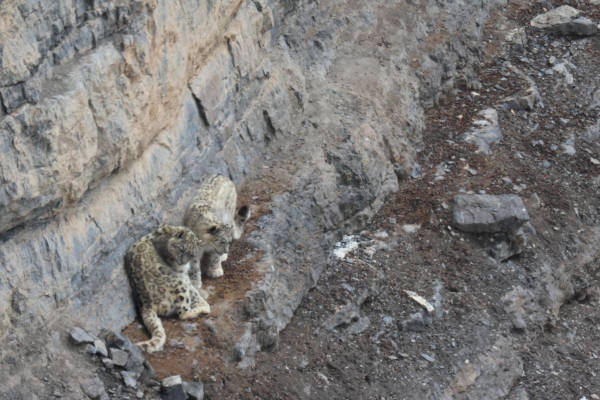
[The snow leopards]
Any hopes of some action, even perhaps the spectacle of a live hunt, were quickly dashed. The leopards seemed to be only stretching their limbs and, perhaps born out of an innate risk radar, were checking out the place for any lurking dangers. This abridged excursion gave the ibex herd some pause; they headed for higher ground, slowly and steadily without any panic; but their dexterity in negotiating the sheer faces and choosing their footholds left us astounded. Around 4 in the afternoon, as the sun dimmed and the cold breeze picked up, the leopards took off on a long trek, along the length of the mountain face, turned a corner and were gone.
The trackers told us they would be back but they also added that it was unlikely they would be going after any prey. The wind was picking up and the temperature had started dropping; we decided to pack up camp and leave because we wanted to traverse the return path while there was still some daylight. Interestingly, the leopards made a kill—a female ibex—the next day, close to the river bed, but nobody got to record it. The trackers also told us that the leopards had devised a smart way of incapacitating their quarry. Both the leopards and ibex are fleet of foot; but the leopards, who can undermine prey only when they are able to get their teeth around its neck, often while chasing nimble-footed ibex at close quarters have taken to pushing them down deep gorges and then sauntering down to pick up the broken and injured animal at leisure.
It might be remiss of us if we do not mention all the hard work put in by the trackers (out in the zone since 5am, braving the bitter cold) and the porters who not only helped us navigate that difficult terrain but also lugged a lot of stuff to make the day pleasurable. The luggage on their backs included folding chairs, binoculars, lunch, tea, coffee, a variety of snacks (including biscuits and dry fruits), portable crockery, drinking water and a first-aid kit. They helped set up the tripod and occasionally even re-adjusted the lens angles to help us get the best shots. We owe our success in spotting the elusive snow leopards entirely to them.
Mission accomplished, we started preparing for our journey down to the plains. Our destination: Amritsar, sweltering at close to 35-degrees centigrade, a marked change from the sub-zero temperature at Chicham.
But memory is a strange, mysterious faculty. Amritsari heat or Mumbai humidity has failed to darken Spiti’s stark whiteness or blur the image of lounging snow leopards. Call it magic, call it voodoo, call it what you will: the mountains do that to you.
Planning the trip

[Image from Unsplash]
We took six months to plan this trip. Of course, Spiti has been on our mind for much longer, but if we had to pin a timeline to the trip, it all started one afternoon with a call to Banjara Experiences.
The organisers: Banjara Experiences (banjaraexperiences.com) was set up more than 30 years ago by a team of nomads and adventurous spirits who have made it their life’s mission to make the inaccessible accessible. They host leopard expeditions for groups in Spiti Valley, Ladakh and Mongolia.
Best time for a sighting: The Banjara team hosts at least 5-6 such expeditions in January, which are very popular among wildlife photographers and film makers. January, however is a challenging month for city-bred travellers like us. Daytime temperatures hover around minus-10-15-degrees and the mercury drops to sub-minus-30-degrees at night. What made it doubly terrifying was that we had spent most of our winters in Mumbai, a city that shivers when the temperature hits anywhere below 20 degrees. This, combined with the reduced oxygen in the air at altitudes as high as the Spiti Valley, had us in two minds about the expedition. Also, we already had made other travel plans for January and February.
Our first question to the Banjara team was therefore, if we could opt out of the January gig. How about a warmer month, say March?
The team was more than ready to stitch together a customised plan for us, for March. But the question was, would the leopard be as obliging? Of course, there are no guarantees but, what if March was too late for even a chance at sighting the leopard? First of all, the team said, they could not give it to us in writing but in all likelihood, Chicham would get a white March and if there was snow on the ground, a leopard would find its way there.
Health advice: Banjara sent us a detailed health advisory and a list of specialized clothing/equipment required. We also sought their advice on the photographic equipment that would be required, given that snow leopards are shadowy, indiscernible creatures. A word here for future travellers to the region. Banjara’s instructions and guidance note should be taken seriously, it helped that we followed their suggestions and packed accordingly.
Clothing to buy or rent: Clothing played an outsized (pun unintended) role in our planning process, given our ice-bound destination: ice boots, thermals, special trousers and special jackets designed for temperatures below minus-10-degrees. We had some winter wear, but nothing for such temperatures. We decided to buy some and rent some—we picked up a jacket from Decathlon (there are others that offer similar products but the prices vary) that assured us protection at minus-10 degrees and rented the boots and trousers with special linings. We asked around for a rental company and scoured the Internet for names and reviews too until we found Bragpacker (Mumbai has three to four outfits that rent out mountaineering and hiking gear and you can choose the one that best suits your needs). We wanted to check out the sizes and Bragpacker (bragpacker.com) was more than happy to have us over at their tiny office in Andheri (West) for a trial.
Photography equipment: We did the same for photographic equipment. Given the snow leopard’s shy and retiring nature and the hazardous nature of its habitat, it was quite likely that we would be shooting from long distances, thereby necessitating super telephoto lenses and tripods for lens stability. We had a Canon EOS R7 mirrorless camera with an RF-S 18-150mm f3.5-6.3 lens which, though also is a telephoto at the 150mm end, was clearly inadequate for the task at hand. So, lenses were also rented from Pune-based company Primes and Zooms (primesandzooms.com): a Canon RF 800mm f/11 lens coupled with a Canon RF 2X extender which would then extend focal length to 1600mm. The tripod, necessary since a long lens held in hands invariably leads to some shake (even if imperceptible) and could potentially mar the end result, was borrowed from a friend.
Car tip: Ask for a car that has snow chains because driving in the higher, snow-bound reaches without chains on tyres can be quite risky. We had an Innova at our disposal that was comfortable, suitably rugged for the rough and rocky Himachal roads and came well equipped for the snowy climb.
Now we were finally set for the trip.
How to get there
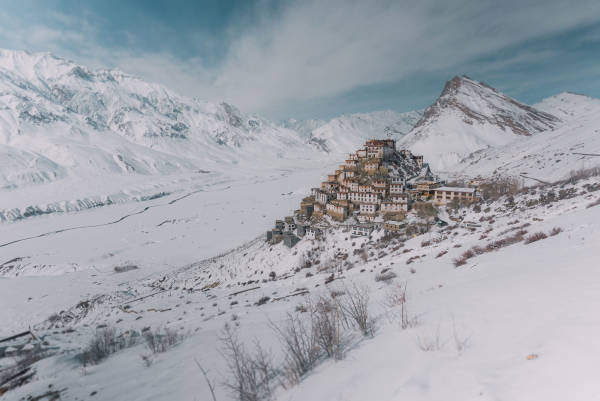
[Courtesy Banjara Experiences]
Mumbai-Chandigarh
(Multiple flights and trains)
Chandigarh-Spiti (via Thanedar and Sangla)
- Day One: Chandigarh to Thanedar; past Solan, Kandaghat, Shimla and Chail.
- Night stay at Banjara Orchard Retreat in Thanedar (We had to shift to Woodvista at the last moment due to some unforeseen hiccup)
- Day Two: Thanedar to Sangla, via Theog, Narkanda, Kumarsain, Rampur Bushahr and Kharcham
- Nights Two & Three: Banjara Valley Retreat at Sangla in Kinnaur district
- Day Four: Sangla to Chicham, via Karcham, Reckong Peo, Pooh, Khab, Nako, Tabo and Kaza
- Days Five to Eight: Stay at Tethys Himalayan Den in Chicham Khas.
- Day Nine: Chicham to Rampur Bushahr: via Kaza, Tabo, Nako, Khab, Pooh, Reckong Peo and Karcham.
- Stay at Nau Nabh Heritage
- Day Ten: Rampur Bushahr to Amritsar: via Narkanda, Shimla, Darlaghat, Mandi, Kiratpur Sahib, Anandpur Sahib, Phagwara and Jalandhar.

